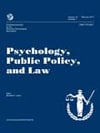Experts in the field of violence risk assessment and psychopathy caution against the use of the PCL-R in predicting institutional violence among high-security custodial settings. This is the bottom line of a recently published article in Psychology, Public Policy, and Law. Below is a summary of the research and findings as well as a translation of this research into practice.

Featured Article | Psychology, Public Policy, and Law | 2020, Vol. 26, No. 2, 133-144
Statement of Concerned Experts on the Use of the Hare Psychopathy Checklist-Revised in Capital Sentencing to Assess Risk for Institutional Violence
Authors
David DeMatteo, Drexel University
Stephen D. Hart, Simon Fraser University
Kirk Heilbrun, Drexel University
Marcus T. Boccacini, Sam Houston State University
Mark D. Cunningham, Seattle, Washington
Kevin S. Douglas, Simon Fraser University
Joel A. Dvoskin, University of Arizona College of Medicine
John F. Edens, Texas A&M University
Laura S. Guy, Simon Fraser University
Daniel C. Murrie, University of Virginia
Randy K. Otto, University of South Florida
Ira K. Packer, University of Massachusetts Medical School
Thomas J. Reidy, Monterey, California
Abstract
Psychopathy as measured by the Hare Psychopathy Checklist—Revised (PCL–R; Hare, 1991, 2003) is related to a range of rule-breaking and antisocial behaviors. Given this association, psychopathy has received considerable attention from researchers and legal professionals over the past several decades. Concerns remain, however, about using PCL–R scores to make precise and accurate predictions in certain contexts, including an individual’s risk for committing serious violence in high-security custodial facilities. After a brief introduction to psychopathy and the PCL–R, we discuss capital sentencing in the United States and then summarize the empirical literature regarding the ability of PCL–R scores to predict violence, with a particular focus on the PCL–R’s ability to predict serious institutional violence. As described, we believe the research demonstrates that the PCL–R cannot precisely or accurately predict an individual’s risk for committing serious violence in high-security custodial facilities. Finally, we present a Statement of Concerned Experts that summarizes our findings and opinions, concluding the PCL–R cannot and should not be used to make predictions that an individual will engage in serious institutional violence with any reasonable degree of precision or accuracy, especially when making high-stakes decisions about legal issues such as capital sentencing.
Keywords
psychopathy, Psychopathy Checklist—Revised, violence risk, institutional violence, capital
sentencing
Summary of the Research
“Much of this [psychopathy] literature focuses on the use of the Hare Psychopathy Checklist—Revised (PCL–R; Hare, 1991, 2003), a psychological rating scale that is often identified as the “gold standard” for the assessment of psychopathy. Perhaps the best summary of the literature to date is that symptoms of psychopathy, as assessed using the PCL–R, are associated with general rule-breaking and trouble-making across settings and populations. But serious concerns have been expressed about the limitations of using both research on psychopathy and scores on the PCL–R to make reliable (i.e., consistent) and accurate (i.e., valid) predictions. This is especially true when those predictions concern specific individuals, specific populations, specific antisocial acts, and specific settings or are made with the goal of assisting decisions about specific legal issues.” (p.134)
“The disorder currently known as psychopathy has been recognized by various names for hundreds of years, but the conceptualization of psychopathy historically included a wide range of poorly defined and conceptually inconsistent traits” (p.134)
“As conceptualized by Cleckley, Karpman, and others who followed them, psychopathy refers to a distinct constellation of interpersonal, affective, and behavioral personality traits that are extreme and maladaptive, including egocentricity, lack of empathy, shallow affect, impulsivity, and a tendency to violate social norms.” (p.134)
“Since the 1980s, the construct of psychopathy often has been operationalized using instruments developed by Robert Hare and colleagues, including the Psychopathy Checklist (PCL), later revised and eventually commercially published as the Hare Psychopathy Checklist—Revised (PCL–R). The Hare scales (as they are sometimes referred to) appear to reflect the interpersonal and affective characteristics of the disorder highlighted by Cleckley (1941), Karpman (1946, 1948), and others better than do many other commonly used psychological tests and diagnostic criteria.” (p.134)
“When considering the role of future dangerousness in capital sentencing proceedings, it is important to frame the question properly. As noted, at the capital sentencing stage, the jury usually deliberates between sentencing the defendant to death or life in prison; in most cases, release to the community is not an option, at least in the foreseeable future and barring unforeseen circumstances.” (p.136)
“Many courts have explicitly recognized that violence risk assessments in capital cases are specific to the prison context (e.g., United States v. Sablan, 2006), although some have taken a broad and amorphous view of what it means to be a potential “danger to society”. (p.137)
“In a large meta-analysis of published and unpublished studies, Guy, Edens, Anthony, and Douglas (2005) coded 273 effect sizes to examine the association between PCL, PCL–R, and PCL:SV scores and institutional misconduct in civil psychiatric, forensic psychiatric, and correctional facilities. Importantly, they were able to specifically analyze the association with more serious institutional violence, in this case, physical violence (i.e., any actual or attempted physical harm). The association between total scores and physical violence was small (rw = .17) – indeed, much smaller than the typical violence risk assessment meta-analytic effect sizes, which are best described as moderate in size (rs ≅ .30 –35)” (p.137)
Translating Research into Practice
“Not only do PCL–R scores lack probative value with respect to determining risk for serious institutional violence, there is compelling evidence to suggest that characterizing defendants as “psychopaths” has a substantial prejudicial impact that may make jurors more inclined to support the death penalty for them.” (p.134)
“The PCL–R is a 20-item symptom construct rating scale for the assessment of psychopathy in adult correctional offenders and forensic mental health patients. Each of the 20 items reflects a different (putative) feature or characteristic of psychopathy… Total score ranges from 0 to 40, with higher scores indicating higher levels of psychopathy. Scores of 30 and higher are frequently considered diagnostic of psychopathy, although the PCL–R manual makes clear that this is a cutoff of convenience. Although the general descriptive utility of this particular cutoff is supported by research, it is nevertheless arbitrary. There is no good theoretical or empirical basis for assuming that psychopathy forms a natural taxon; indeed, most research tends to support the view that psychopathy is most parsimoniously and usefully conceptualized in dimensional rather than categorical terms” (p.135)
“One strength of PCL–R scores is their high level of interrater reliability (i.e., agreement among independent evaluators with respect to PCL–R scores) reported in professional manuals and in many published research reports… But interrater reliability is a property of scores obtained for a particular sample of people and in a particular context; it is not a stable property of the test itself that necessarily generalizes across samples or contexts. Research conducted over the past 10 to 15 years raises concerns about the interrater reliability of PCL–R scores made in psycholegal contexts, and several caselaw reviews have examined the interrater reliability of PCL–R scores in court cases.” (p.135)
“…there is a tendency for prosecution retained evaluators to report higher PCL–R scores than do defense retained evaluators in evaluations of the same person, made around the same time, and even when made on the same information base. This tendency for some experts to drift from more objective findings to ratings that better support the party that retained them has been termed adversarial allegiance.” (p.135)
“…the overall association between PCL–R scores and violence at the group level is only moderate in terms of effect size, both in absolute terms and relative to the effect size of other established risk factors for violence; the association between PCL–R scores and violence in institutional settings is small in terms of effect size; and the association between PCL–R scores and serious institutional violence is negligible. Our conclusion based on these findings was that one cannot use the PCL–R in the context of capital sentencing evaluations to make predictions that an individual will engage in serious violence in high-security institutional settings with adequate precision or accuracy to justify reliance on the PCL–R scores.” (p.138)
Other Interesting Tidbits for Researchers and Clinicians
“…it is useful to note that if the ICC for PCL–R ratings in adversarial legal proceedings do in fact approximate .60 as suggested above, then the corresponding 95% confidence interval around an average PCL score would fall between the 11th and 89th percentiles. This analysis ignores certain important qualifiers, such as the fact that the PCL–R normative data are not normally distributed and that reliability estimates are not constant across the range of possible test score results (i.e., they tend to decrease the further away an obtained score is from the mean), which may further reduce the expected agreement among raters.” (p.135)
Join the Discussion
As always, please join the discussion below if you have thoughts or comments to add!






















